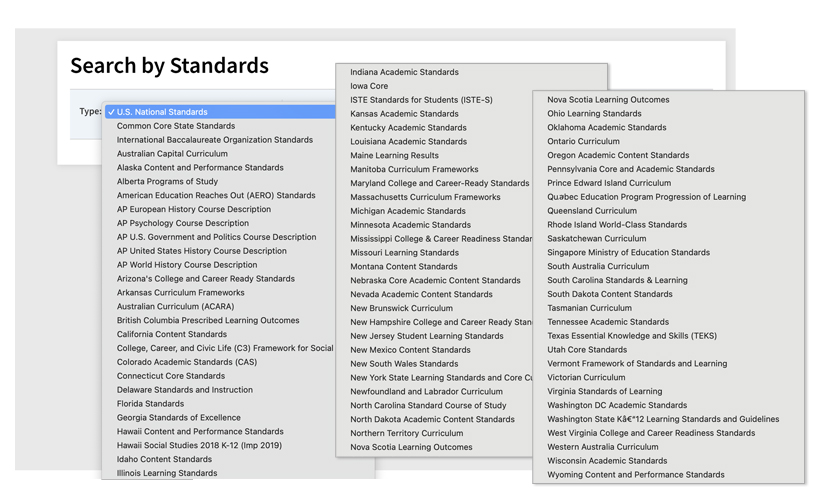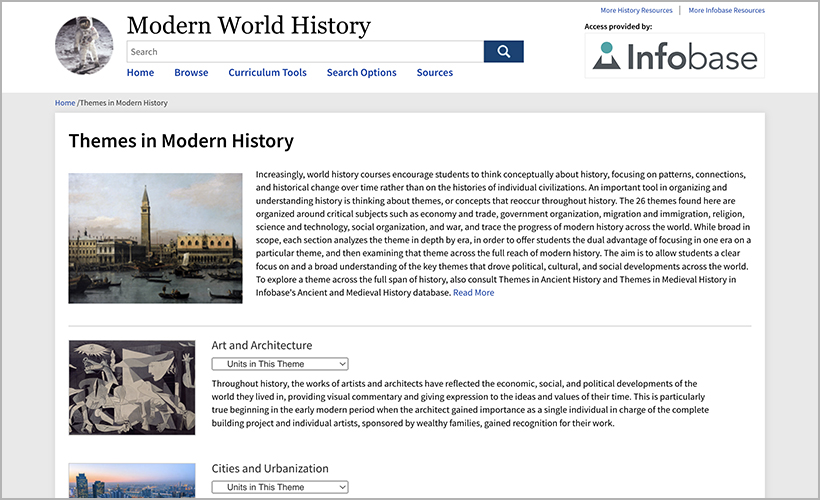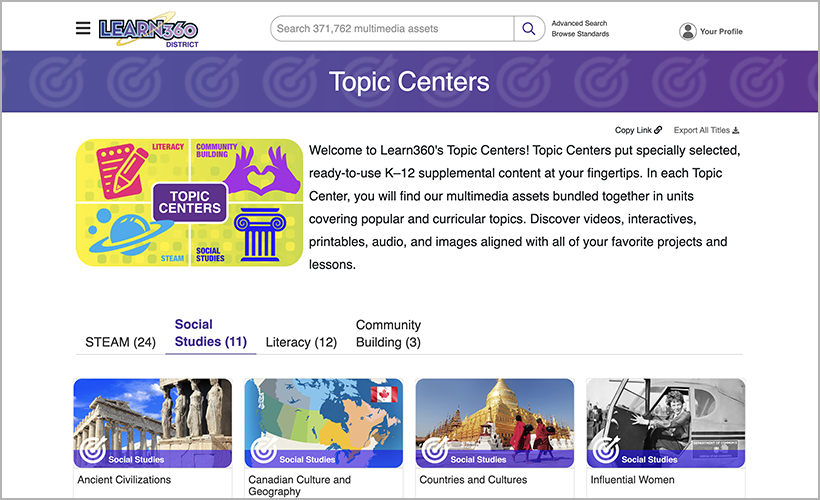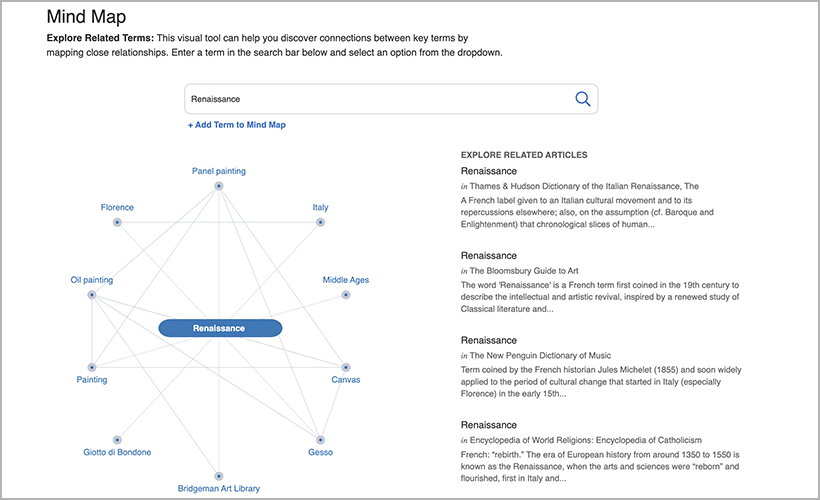Support Your History Instruction with Curated Multimedia Content

It has been said that those who ignore history are doomed to repeat it. This is one of the many reasons history instruction is so crucial for a functioning society. Students need to understand how the events of the past have shaped those of today. Infobase’s history resources are rich with relevant content on core topics in the academic curriculum.
Get Content Aligned with Academic Standards
School teachers and homeschoolers alike rely on national, state, and provincial academic standards to help them build curricula that ensure students meet every benchmark. Infobase’s supplemental resources not only feature content that is aligned to major educational standards, but also offer the ability to search and browse content by them.
Infobase’s History Research Center databases—including American History, African-American History, American Indian History, Ancient and Medieval History, and Modern World History—each have a “Search By Standards” feature next to the Search bar at the top of the screen that allows users to search by Common Core, national, state, provincial, Australian, International Baccalaureate Organization, C3 Framework for Social Studies, and College Board AP standards to find correlating articles. Infobase’s streaming video platforms for schools, Learn360 and Classroom Video On Demand, both have a Browse Standards feature that includes all of the above-mentioned standards plus 21st Century Skills. Select the standard in the drop-down menu on the left and then narrow your selection by grade and subject to get a list of standards that link to correlated content.

Explore Themes in U.S. and World History
Studying history isn’t just about memorizing facts, events, and dates. In order to present a broader perspective and to cultivate a deeper understanding of history, many educators will group events and historical details by theme to encourage students to compare and contrast them across time. These educators need assets that are designed to foster critical conceptual thinking about the unifying threads throughout history—especially since students today, particularly those taking honors-level and AP-level history courses, are encouraged to think conceptually about history and to focus on historical change over time.
American History, Ancient & Medieval History, and Modern World History each feature sections on themes in history that allow students to focus on a particular theme in one era or region and then examine that theme across the span of history. These sections are:
- Organized around such critical subjects as climate and geography, agriculture, demographics, economics, daily life, government, religion, migration and population movements, social organization, science and technology, war, women, and more
- Designed to help students develop a clear focus on and a broad understanding of the key themes that drove political, cultural, and social development
- Aligned to AP thematic learning objectives
- Designed to assist students in preparing for AP long essay questions
- Feature discussion questions for each theme that foster critical-thinking skills and provide opportunities for observation, analysis, interpretation, reflection, and evaluation of themes
Look for the themes in history sections, which can be accessed under Browse Resources in the following Infobase history databases:
- Themes in Ancient History: Find it in Ancient & Medieval History
- Themes in Medieval History: Find it in Ancient & Medieval History
- Themes in Modern History: Find it in Modern World History
- Themes in U.S History: Find it in American History

“Present the Stimulus” with Streaming Video and More
The fourth event in Gagne’s Nine Events of Instruction is to “present the stimulus,” when—after gaining students’ attention, informing them of the objectives, and reminding them of related topics they’ve already learned—you finally present learners with the information you have selected for them to learn today. There are many ways to approach this step, but incorporating video and other media brings a visual element to your lessons that can stimulate learning.
Each of Infobase’s History Research Center databases feature videos that offer a fascinating visual introduction to key topics and themes—a great way to stimulate interest and kick off lessons and lectures. Educators can also find images, original maps, and original, interactive whiteboard-friendly slideshows to put a face on history and help put the subject being studied into perspective.
Looking for documentaries and more in-depth video content? Educators can introduce important events in history with video from Infobase’s streaming video platforms—including Learn360 for K–12 schools and districts and Classroom Video On Demand for secondary schools. These platforms feature exceptional content from the world’s top producers, including A&E, History Education, PBS, the BBC, Makematic, Ken Burns, and many others. Many titles also feature lesson plans and educator guides to give you ideas on how to use them in your classroom.
K–12 educators will also appreciate Learn360’s history-related Topic Centers, each of which bring together all the multimedia assets teachers need to take their lessons to the next level. Find videos, printables, games, and audio recordings on curricular history subjects including:
- Ancient Civilizations
- U.S. Civil War
- U.S. Government and Constitution
- U.S. Presidents
- U.S. Revolutionary War
- World Wars One and Two

Encourage Inquiry-Based Learning
Sometimes, the best way to inspire learning in students is to present them with a fascinating fact from history, encourage them to ask questions about it, and have them research the answers. Inquiry-based learning works by building off of students’ natural curiosity—and, with the best tools for research, students can find many topics to be curious about.
Credo Source for high schools is an excellent place to guide students during an inquiry-based learning exercise. Not only will they have access to the best in history reference from renowned publishers such as Oxford University Press, Salem Press, McFarland, Gale, Britannica Digital Learning, and Facts On File, but they get access to Credo’s Mind Map, a visualization tool to help users discover connections between and across topics—the perfect tool for sparking more curiosity and inspiring further inquiry.

In addition, Infobase’s History Research Center databases each feature Topic Centers that can be used in inquiry lessons. Topic Centers feature content specially selected by our editors—articles, shareable slideshows, videos, primary sources, and more—on different curricular historical topics, providing students with valuable study guides and mini-virtual libraries of multimedia that are perfect for starting research. Ask students a question about a historical topic, perhaps introducing it with a video, and then have them use content in the Topic Centers to answer the question.